The Victorian Freak
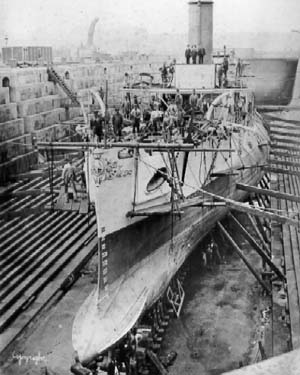 Among the “oddballs” of the Royal Navy, HMS Polyphemus is many’s favourite. She was unlike any other vessel in the Royal Navy. This “Victorian Freak” was born from 1872 studies from the “Torpedo Committee”. Initially a much larger and faster version of Vesuvius. But it was modified during design by KNB Daniel Barnaby, grew in size, gained a ram, and was eventually ordered on 5 February 1878. She was a very peculiar ship for her hull shape, side torpedo tubes, ballasted hull sitting very low, and reinforced ram. She was prepared for a possible war with Russia and attack Kronstadt Harbour. However, progresses in artillery made her no longer relevant, and she was sidelined, placed in reserve, and eventually Sold for BU on 7 July 1903.
Among the “oddballs” of the Royal Navy, HMS Polyphemus is many’s favourite. She was unlike any other vessel in the Royal Navy. This “Victorian Freak” was born from 1872 studies from the “Torpedo Committee”. Initially a much larger and faster version of Vesuvius. But it was modified during design by KNB Daniel Barnaby, grew in size, gained a ram, and was eventually ordered on 5 February 1878. She was a very peculiar ship for her hull shape, side torpedo tubes, ballasted hull sitting very low, and reinforced ram. She was prepared for a possible war with Russia and attack Kronstadt Harbour. However, progresses in artillery made her no longer relevant, and she was sidelined, placed in reserve, and eventually Sold for BU on 7 July 1903.
Development
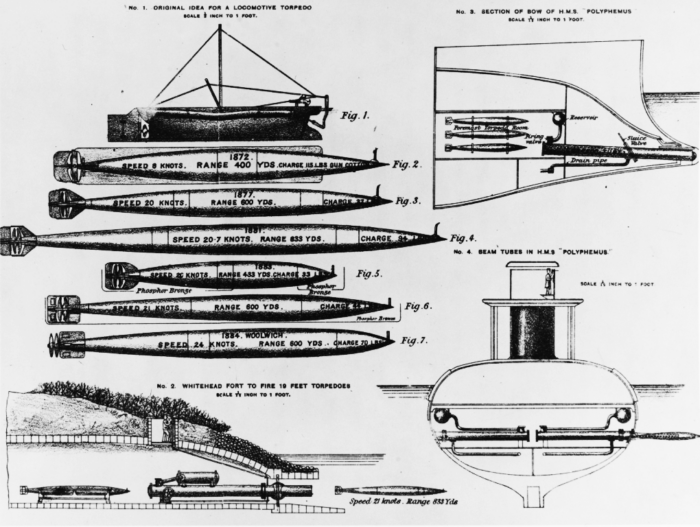
The Admiralty created the “Torpedo Committee” in 1872 to take advantage of the recently invented and perfected Whitehead torpedo in RN operations at sea. The Royal Navy procured torpedoes and tubes and started to look out for ways to launch these with a suitable vessel. Its first attempt was the torpedo launching ship HMS Vesuvius which saw last month. Although hardly a “torpedo boat” in the modern sense (its maximum speed was less than 10 knots) she was designed as a stealthy harbour attack weapon, capable of sneaking in by night due to her low profile and approach a few hundred yards of enemy ships before launching her torpedoes. The concept proved now that easy and the ship was soon sidelined after its appearance in 1878 at Spithead. The vessel that robbed attention was instead HMS Lightning, truly the forebear of all TBs.
 By late 1874 already as Vesuvius was just launched, Sir Nathaniel Barnaby* and his assistant J. Dunn proposed to the admiralty an alternative design that would be even more radical in its approach, for the same goal. He drafted a fast cigar-shaped vessel armed not with one or two but five submerged torpedo tubes, protected by 2 inches of armour over the deck. The basic concept was that the hull shapes would deflect the slow velocity shots of the time, even using ballasts used to lower it artificially lower than these guns at close range. Having torpedoes on the sides and forward offered more flexibility.
By late 1874 already as Vesuvius was just launched, Sir Nathaniel Barnaby* and his assistant J. Dunn proposed to the admiralty an alternative design that would be even more radical in its approach, for the same goal. He drafted a fast cigar-shaped vessel armed not with one or two but five submerged torpedo tubes, protected by 2 inches of armour over the deck. The basic concept was that the hull shapes would deflect the slow velocity shots of the time, even using ballasts used to lower it artificially lower than these guns at close range. Having torpedoes on the sides and forward offered more flexibility.
* Sir Nathaniel Barnaby, KCB (25 February 1829 – 16 June 1915) was Chief Constructor of the Royal Navy from 1872 to 1885. During these he saw 12-inch muzzle-loading rifles replaced by 16.25-inch breechloaders, secondary armament and central citadels, barbettes, turrets and development of the torpedo as well as the end of rigging.
The admiralty was interested, but soon stated that provided it had the right output and speed, it would be useful as ram as well, a secondary weapon for such attacks, and provided guns for self defence as well as disrupting last minute counter-battery. Thus, the design was modified in late 1875, became much larger, notably because the hull needed to be modified for the ram, and more engine room space. Early in 1876, this design was modified again and became eventually a 240-foot-long (73 m) unarmoured torpedo ram. Its targeted top speed was 17 knots, which was blistering fast even in 1876. The design was modified yet again in 1877 to have more armour to the exposed steel deck and the protection scheme was revised again.
HMS Polyphemus was eventually approved by the admiralty, ordered on 5 February 1878, laid down on 21 September 1878 at Chatham Naval Dockyard, launched on 15 June 1881, completed in September 1882 so after five years of construction and four years of conception and design refinements. The new vessel was named “Polyphemus” in reference of Odysseus’ mythical one-eye giant, due to its ram. Technology however went a long way in between the idea and completion. Because of this probably, a second ship of the same design also ordered from Chatham on 30 December 1881, was cancelled on 10 November 1882 and a revised design placed on 6 March 1885 to the same yard, to be named HMS Adventure, was also cancelled on 12 August 1885. The torpedo ram experiment was terminated, as the Admiralty saw the writing on the wall for the combination of still a slow speed and vulnerability to modern shells.
Design of the class
Hull and general design
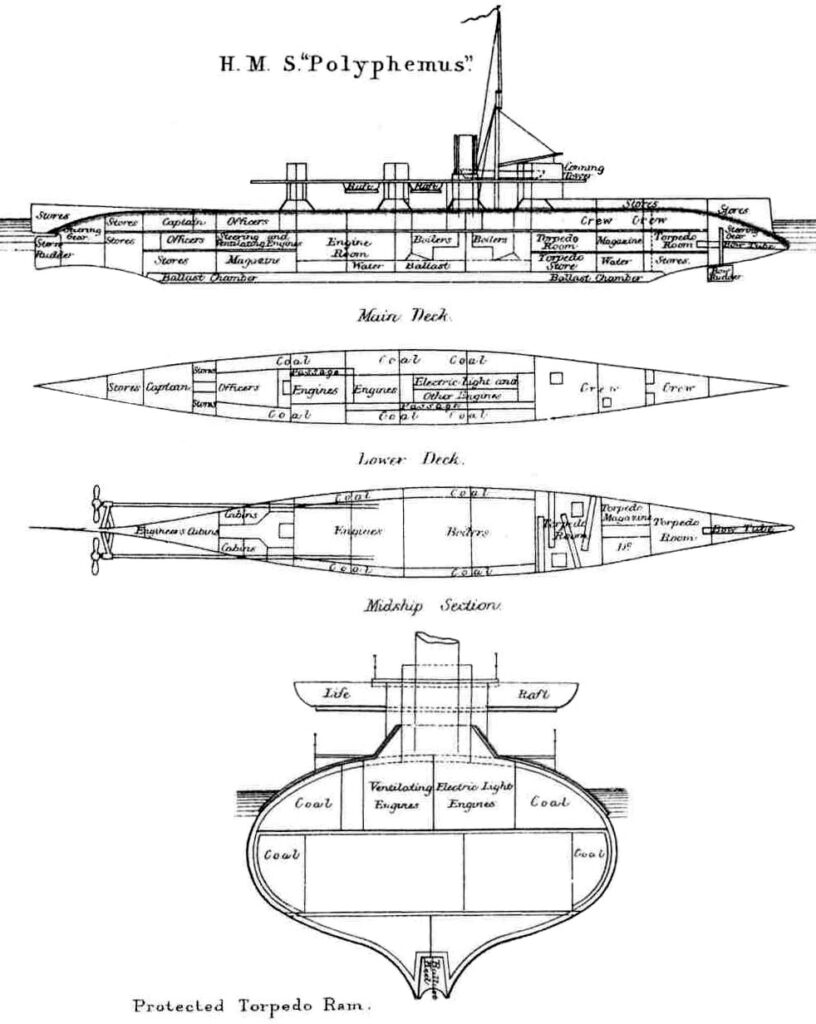
Polyphemus was much larger than HMS Lightning or Vesuvius and a completely new animal. In displacement, she was rated at 2,640 tons for an overall length of 240 ft (73 m), a Beam of 37 ft (11 m) and draught of 20 ft 6 in (6.25 m). The hull was very peculiar. It was closer to a submarine that anything else, with prominent bulges either side, a well-rounded hull which started sloping up from a rather high waterline (up to the deck it was 3/4 submerged, 1/4 emerged). This of course was by design. She was made less buoyant, with partly fixed and partly jettisonable ballast to make her sit way further below water as she would normally do. Among other peculiarities, her 250-ton cast iron keel which could be released in an emergency, to increase the hull buoyancy, held in place by two spindles which needed to turned to release the keel. The system was well tested. The bulk of the extra weight was a large water ballast tank located just above the keel and its own ballast chamber.
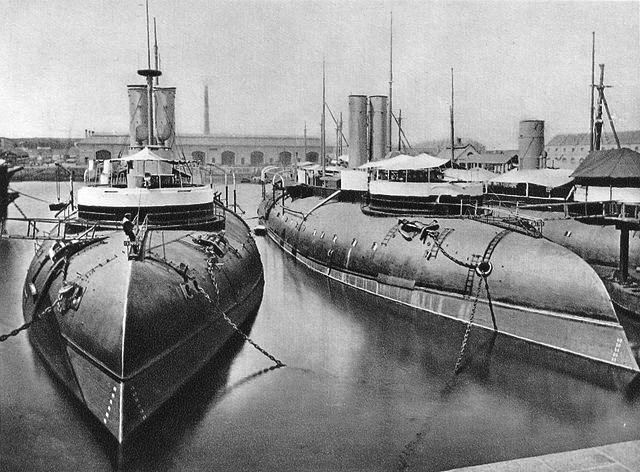
The core idea there was no different that the French approach to their own ironclad rams such as the Taureau class (“bull”). The latter was built in 1865-66 and already looked like a reversed hull, with the bottom up. The peculiar armoured hull shape was a way to deflect shots. This was just at the end of the American Civil War and took some inspiration from various vessels, notably the USS Galena. The fact the French built a whole class of five of them, showed their confidence in the concept. The idea of using surrounding water as a protection went a long way and others concepts would test the idea, notably the later Italian “submersible battleship”.
Anyway, the Polyphemus had a nice spindly shape from bow to stern, with very fine entry lines, a low freeboard, a narrow flat deck only forward, with a structure which reinforced the ram extension, and a narrower flat deck aft. Behind the armoured sides were large coal storage, occupying most of the vitals amidships and notably the narrow space left for the engine room. The torpedo room with the forward bow tubes and side tubes occupied most of the forward section. Superstructures were reduced to the minimum: A conning tower forward, and one single funnel, with a composed mast between the CT and funnel, taller than the rest. There were als smaller conning towers amidship and aft of the “flying bridge” which could be apparently removable and float by itself. The crew amounted to 80, not a lot for that amount of armament, which for a ship with such odd shapes and lost space to coal and ballast, remained quite cramped. There were two boats under davits on either side of the flying bridge, close to the mast.
Powerplant
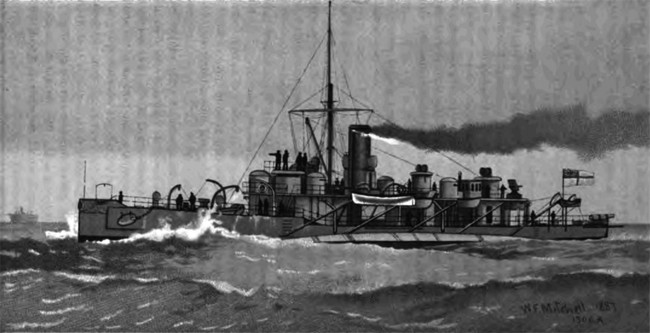
There are conflicting number among sources about its composition. The only certain part was the set of two propeller shafts, connected to two 4-cylinder Horizontal Compound esteam engines, fed in turn by either ten or twelve (conflict there) loco boilers, the lighweight type adopted for torpedoes boats, for a total of 5,500 ihp on normal drught and 7,000 hp in forced draught. The coal bunjkerage was 400 tonnes in some sources, 200t in others. Outside of its twin boiler and separate engine rooms, low turtle-back hull, submerged at speed, she could still carry 200 tons of coal, up to 300 tons in wartime.
The main raison d’être of the powerful engines and steam were the ram. The Battle of the Lissa in 1966 showed that combining steam power and ramming were a powerful combination, and its ramifications influenced naval doctrine in one form or another for decades. The ram, exhumed from archaeological studies, became fashionable again, thanks to steam, which replaced rowing as a wind-free locomotion. But for this, speed needed to be at least of 17 knots, of possible 18 and more. Part of the solution was in the choice of loco boilers, cylindrical and thus, which could be overheated.
Range was expressed as being “capable of making a passage in any weather from Plymouth to Gibraltar, or from Gibraltar to Malta at 10 knots without assistance”… It was estimated at 1700 nm (3,148 km) at 10 kts. As for the 17 knots, they were her nominal speed, but on force draught she was allegedly capable to reach 17.8 to 18 knots on trials, but on normal draught, only 15 knots, not better than most ironclads of the time.
It should be said that in addition of her steam powerplant she had a 80-volt electric lighting installed, adopted by the Royal Navy in 1882 following a fatal electrocution aboard HMS Inflexible using a 800-volt circuit. This was a first.
Protection
It was limited to a steel curved deck 76 mm or 3 inches in thickness encompassing not only the hull’s sides down to c50 cm or 19 inch below the waterline, but aslo the central bulwark over the deck. It was made in compound armour, with steel over iron, with hatch coamings 4-inches thick (105 mm) and the conning tower having 8-inches walls (200 mm). Behind the armour was the regular iron hull and inside were compartment fills with coal. The upper ones represented 50% of the upper beam and partly covered the machiney spaces, completely below water. The water ballasts were located below these spaces. She was design to take a beating…
Armament
Polyphemus’ Ram
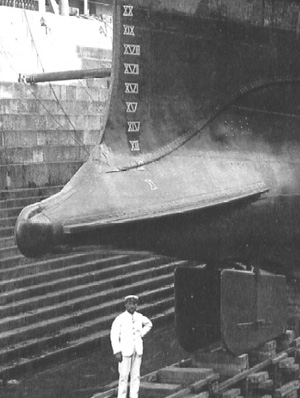 HMS Polyphemus had a ram as main “static” weapon, fixed in prolongation of the hull and of the armooured turtledeck which sloped down towards the splindle formed by the hull nose. It was protruding a few meters, not ending with an edge but a bawl, and throughly reinforced, notably on both sides to avoid being torn off. The “bawl” was in fact the protruding centre torpedo tube, fitted with a combined cast steel bow cap and ram, hinged upwards to open. Engineers worked to obtain the best hydrodynamic design through model testing. This feature was about to have indeed a major impact on the ship’s performance and was in essence a very early bulbous bow example.
HMS Polyphemus had a ram as main “static” weapon, fixed in prolongation of the hull and of the armooured turtledeck which sloped down towards the splindle formed by the hull nose. It was protruding a few meters, not ending with an edge but a bawl, and throughly reinforced, notably on both sides to avoid being torn off. The “bawl” was in fact the protruding centre torpedo tube, fitted with a combined cast steel bow cap and ram, hinged upwards to open. Engineers worked to obtain the best hydrodynamic design through model testing. This feature was about to have indeed a major impact on the ship’s performance and was in essence a very early bulbous bow example.
The bow also featured a balanced two-bladed rudder fitted underneath. They were fully be retractabe into the hull if needed, and allowed agility when moving astern, disengaging from the enemy’s hull. When used in combination with the regular stern rudder it also reduced the diameter of the turning circle by 12 per cent forward, and was also “sold” as an advantage for melee ramming battles, courtesy of Lissa. There are some mentions that the ram was detachable, which id dubious at best.
Torpedo Tubes
Main feature of the design were five submerged 14-inch torpedo tubes, for a storage of 18 Mark II torpedoes. This was way more than Vesuvius, even more than most torpedo boats and torpedo cruisers that were built later. This partly reflected the lack of confidence in these very early tubes.
Apart the axial bow/ram tube combo, she had four side TTs in the chamber forward of the machinery space. They fired underwater. These were interleaved tubes due to the lack of space, with in order, from back to forward, a starboard 90% angle tube, then same, starboard, then port, 30% forward, the same starboard. Range for the Whitehead Mark I was models, just 600 yards, carrying 26-pound guncotton charge, top speed 18 knots. Meaning they were only marginally faster than Polyphemus…
Nordenfelt Guns
Her gun armament was an afterhtought. Her original gun armament was purely defensive, notably to avoid a boarding and capture and to fight her way off after an attack in close quarters. It comprised 6 twin-barreled Nordenfelt 25mm (1-inch) automatic guns. Later in the 1880s they were replaced, mount for mount, by single barrel Hotchkiss 3-pounder (47mm) quick-firing guns.
⚙ HMS Polyphemus specifications |
|
| Displacement | 2,640 tons |
| Dimensions | 240 x 37 ft x 20 ft 6 in (73 x 11 x 6.25 m) |
| Propulsion | 2 4-cyl. HC, 10 loco boilers 5500/7000 hp |
| Speed | 15-17.8 knots |
| Range | Coal 270t, 1700 nm at 10 kts |
| Armament | 5× 14-inch TT (18 torpedoes), 6× 1-in Nordenfelt, ram |
| Protection | Deck 3 in compound, hatch coamings 4 in, CT 8 in |
| Crew | 80 |
Career of HMS Polyphemus
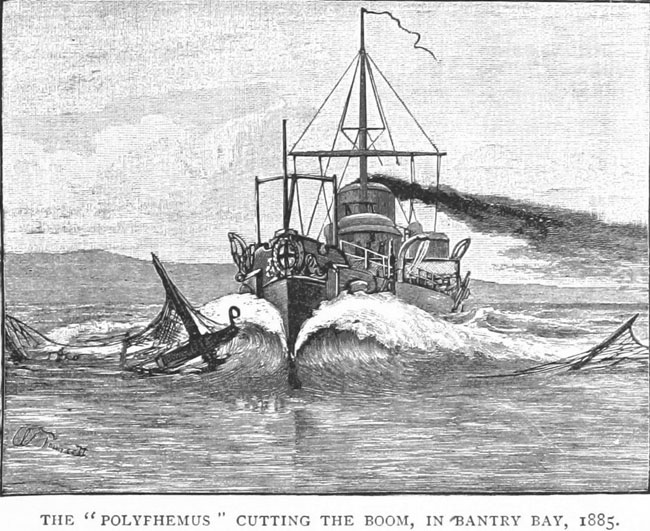
 There is a myth found in many older books about the fact she was inspired by Admiral Sartorius’ ideas on steam rams. So her some debunking. Admiral of the Fleet Sir George Rose Sartorius, GCB (9 August 1790 – 13 April 1885) was a junior officer during the Napoleonic Wars, and witnessed the surrender of Napoleon Bonaparte to Captain Frederick Maitland in HMS Bellerophon at Rochefort. Without a job, he commanded the navy of Dom Pedro, in the Portuguese Civil Wars. He command HMS Malabar in the Mediterranean and hosted the fleeing regent of Spain Baldomero Espartero. When Malabar was paid off in 1844 had had no service at sea but kept active interest in naval affairs, and in pazrticular became one of the earliest advocates of steam ram ships. He was also appointed a naval aide-de-camp to the Queen on 9 November 1846, giving him a tribune for his idea, and he later commander-in-chief at Queenstown. There are many records around the web, based on older books that still until today states Polyphemum was built at Chatham from the designs and advices of the late Admiral of the Fleet Sir GR Sartorious. In reality decomentations of the time mentioned his name nowhere, however Barnaby is present front and center, with the admiralty speaking all along the development of a “torpedo ship”, “improved vesuvius”.
There is a myth found in many older books about the fact she was inspired by Admiral Sartorius’ ideas on steam rams. So her some debunking. Admiral of the Fleet Sir George Rose Sartorius, GCB (9 August 1790 – 13 April 1885) was a junior officer during the Napoleonic Wars, and witnessed the surrender of Napoleon Bonaparte to Captain Frederick Maitland in HMS Bellerophon at Rochefort. Without a job, he commanded the navy of Dom Pedro, in the Portuguese Civil Wars. He command HMS Malabar in the Mediterranean and hosted the fleeing regent of Spain Baldomero Espartero. When Malabar was paid off in 1844 had had no service at sea but kept active interest in naval affairs, and in pazrticular became one of the earliest advocates of steam ram ships. He was also appointed a naval aide-de-camp to the Queen on 9 November 1846, giving him a tribune for his idea, and he later commander-in-chief at Queenstown. There are many records around the web, based on older books that still until today states Polyphemum was built at Chatham from the designs and advices of the late Admiral of the Fleet Sir GR Sartorious. In reality decomentations of the time mentioned his name nowhere, however Barnaby is present front and center, with the admiralty speaking all along the development of a “torpedo ship”, “improved vesuvius”.
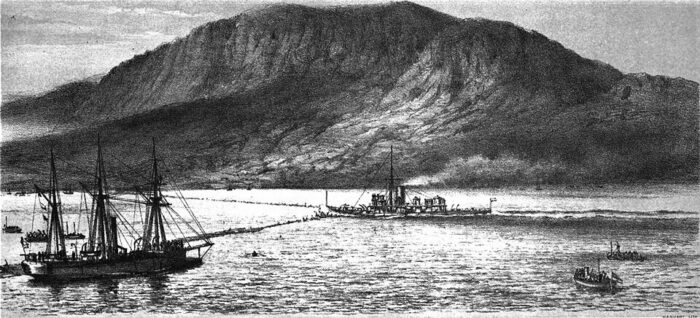
HMS Polyphemus’ career was as boring as Vesuvius, and in contrast with her design and concepts. HMS Polyphemus served at first with the Mediterranean Fleet.
In 1884, she was reboilered with eight new, larger cylindrical boilers instead of her collection of loco boilers. She had also her six 2-barreled 25mm/40 Nordenfelt treplaced by two 6-pdr (57mm/40) Hotchkiss Mk I, and four 4-tubes 25mm/40 Nordenflt. Then in 1887 or 1888, she lost her four remainder Nordenfelt for four 57mm/40 or 6pdr Hotchkiss Mk I, making six. That was her last alteration.
Her most interesting feat at the time was the 1885 Berehaven trial: She undertook a simulated attack on a fleet at anchor, at Berehaven. This simulated an attack on Kronstadt Harbour in the event of a war with Russia (for context there was a real fear at the time and arms race between Britain and Russia). To get through booms and nets and see if it would to catch propellers, nets of the same type were laid across the channel behind Bereshaven, with small observation mines.
The whole area before the nets were defended by machine guns and torpedo boats. Polyphemus launched a simulated attack on 30 June, evaded around ten torpedoes fired by 6 torpedo boats and ended her two-mile run by smashing through the booms and breaking the 5-inch steel hawser holding them in place.
This was spectacular, but no more trials were made afterwards.
By the late 1880s the new quick-traversing and quick-firing guns rendered her concept less appealing. When designed back in 1872, the only guns capable of penetrating her armour were just too slow to train and fire. But now only capable of 17 knots and weakly protected, she was a sitting duck.
She saw little service afterwards, and was ultimately paid off at Chatham Dockyard in January 1900. In April 1902 she became a tender to HMS Defiance the torpedo school at Devonport. She ws stircken and sold for breaking up on 7 July 1903.
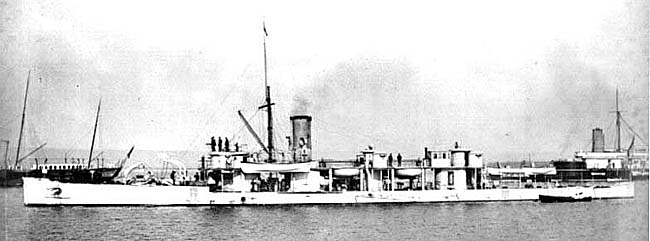

Read More/Src
Books
Links
https://navypedia.org/ships/uk/brit_dd_polyphemus.htm
https://en.wikipedia.org/wiki/HMS_Polyphemus_(1881)
Nice model at the Greewhich Coll. Museum, showing her hull partly underwater.
https://www.rmg.co.uk/collections/objects/rmgc-object-67073
Videos
Model Kits
None
3D
None

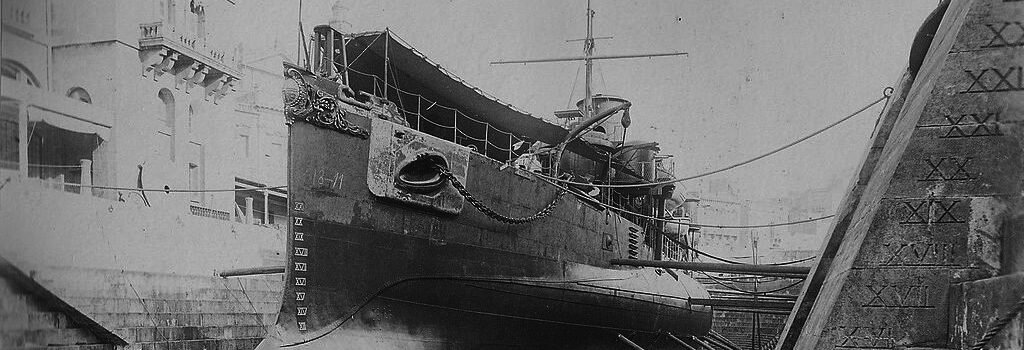

 Latest Facebook Entry -
Latest Facebook Entry -  X(Tweeter) Naval Encyclopedia's deck archive
X(Tweeter) Naval Encyclopedia's deck archive Instagram (@navalencyc)
Instagram (@navalencyc)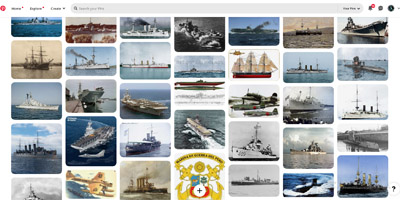


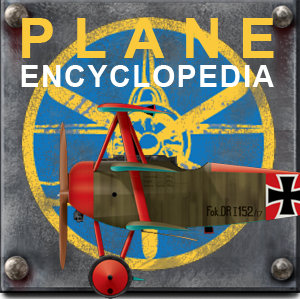
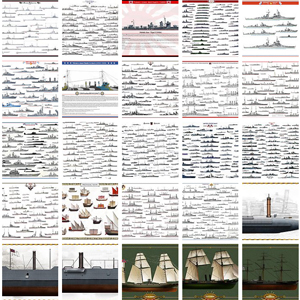

 French Navy
French Navy Royal Navy
Royal Navy Russian Navy
Russian Navy Armada Espanola
Armada Espanola Austrian Navy
Austrian Navy K.u.K. Kriegsmarine
K.u.K. Kriegsmarine Dansk Marine
Dansk Marine Nautiko Hellenon
Nautiko Hellenon Koninklije Marine 1870
Koninklije Marine 1870 Marinha do Brasil
Marinha do Brasil Osmanlı Donanması
Osmanlı Donanması Marina Do Peru
Marina Do Peru Marinha do Portugal
Marinha do Portugal Regia Marina 1870
Regia Marina 1870 Nihhon Kaigun 1870
Nihhon Kaigun 1870 Preußische Marine 1870
Preußische Marine 1870 Russkiy Flot 1870
Russkiy Flot 1870 Svenska marinen
Svenska marinen Søværnet
Søværnet Union Navy
Union Navy Confederate Navy
Confederate Navy Armada de Argentina
Armada de Argentina Imperial Chinese Navy
Imperial Chinese Navy Marinha do Portugal
Marinha do Portugal Mexico
Mexico Kaiserliche Marine
Kaiserliche Marine 1898 US Navy
1898 US Navy Sovietskiy Flot
Sovietskiy Flot Royal Canadian Navy
Royal Canadian Navy Royal Australian Navy
Royal Australian Navy RNZN Fleet
RNZN Fleet Chinese Navy 1937
Chinese Navy 1937 Kriegsmarine
Kriegsmarine Chilean Navy
Chilean Navy Danish Navy
Danish Navy Finnish Navy
Finnish Navy Hellenic Navy
Hellenic Navy Polish Navy
Polish Navy Romanian Navy
Romanian Navy Turkish Navy
Turkish Navy Royal Yugoslav Navy
Royal Yugoslav Navy Royal Thai Navy
Royal Thai Navy Minor Navies
Minor Navies Albania
Albania Austria
Austria Belgium
Belgium Columbia
Columbia Costa Rica
Costa Rica Cuba
Cuba Czechoslovakia
Czechoslovakia Dominican Republic
Dominican Republic Haiti
Haiti Hungary
Hungary Honduras
Honduras Estonia
Estonia Iceland
Iceland Eire
Eire Equador
Equador Iran
Iran Iraq
Iraq Latvia
Latvia Liberia
Liberia Lithuania
Lithuania Mandchukuo
Mandchukuo Morocco
Morocco Nicaragua
Nicaragua Persia
Persia San Salvador
San Salvador Sarawak
Sarawak Uruguay
Uruguay Venezuela
Venezuela Zanzibar
Zanzibar Warsaw Pact Navies
Warsaw Pact Navies Bulgaria
Bulgaria Hungary
Hungary

 Bundesmarine
Bundesmarine Dutch Navy
Dutch Navy Hellenic Navy
Hellenic Navy Marina Militare
Marina Militare Yugoslav Navy
Yugoslav Navy Chinese Navy
Chinese Navy Indian Navy
Indian Navy Indonesian Navy
Indonesian Navy JMSDF
JMSDF North Korean Navy
North Korean Navy Pakistani Navy
Pakistani Navy Philippines Navy
Philippines Navy ROKN
ROKN Rep. of Singapore Navy
Rep. of Singapore Navy Taiwanese Navy
Taiwanese Navy IDF Navy
IDF Navy Saudi Navy
Saudi Navy Royal New Zealand Navy
Royal New Zealand Navy Egyptian Navy
Egyptian Navy South African Navy
South African Navy






























 Ukrainian Navy
Ukrainian Navy dbodesign
dbodesign